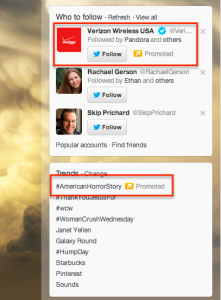With Twitter about to go public, it’s a good time for everyone—not just potential investors—to take another look at how Twitter makes money and why it may affect all of us media consumers.
The short answer, of course, is advertising. The entire internet economy is based on advertising revenue. In fact, I find it’s always helpful to remind myself that this is how Google makes money at a rate that would make Nathan Rothschild’s jaw drop. They’ve perfected ad sales to the point where they’ve created an entire economy out of thin air, which equals big, big money.
Other web businesses don’t have near the same amount of influence, stability, or reach as Google, but that doesn’t mean they’re not profitable. Facebook, for example, clears about $5 billion in revenue per year mainly on ad sales. Even Bing/Yahoo!, the Monkees to Google’s Beatles, is a small but growing revenue source for Microsoft.
Then there’s Twitter. Many use it, but few seem to really understand it. Is it a conveyor belt of bad spelling and celebrity nonsense? Yes. Is it an interesting, instant news tool? Yes. Is it the 21st Century equivalent of a soap box set up on a busy street corner where free speech is virtually uninhibited? …Yes.
As we know, like Google and Facebook, Twitter makes money mainly by selling ads. If you’re a Twitter user, you may notice “promoted tweets,” usually from large brands:
According to the headline article of this week’s Forbes, these tweets will start to take an entirely new form in the near future thanks to public investment and deals with TV. This could mean direct and instant integration between Twitter campaigns and TV programs, short tweets of proprietary video clips meant to gain huge amounts of viewers, and more.
At first, a partnership between old school TV giants and something so rapid, new, and informal like Twitter may not make much sense. After a while, however, the ideas start to fall into place.
Forbes used Breaking Bad as a timely example. While there may be around 500,000 people watching a certain episode at a given time, they say, there are millions of people involved in a conversation around it. Even if you didn’t watch the show, chances are you know a few who did, and probably saw all sorts of uncontrolled excitement, anticipation, and grief filling up your Facebook, Twitter, and ears in the last few weeks. What used to be casual conversation with friends or coworkers is now a shotgunned out to everyone you know.
That’s where TV networks are seeing dollar signs. With such a huge user base and a platform built for wide open engagement, a brand (which could even mean a TV show) on Twitter has a huge potential audience that could generate lots and lots of conversation. And here’s where TV’s traditional values start to match up: attention—eyeballs—are the primary concern. The more viewers a show has, the more you can charge for advertising during that time slot. This was TV’s game for decades, their own advertising economy that made them incredibly rich.
What are you going to do about TV in the future? Are you going to “cut the cord” and get away from cable and satellite? Do you talk about your favorite shows on Twitter or Facebook? What about your favorite sports teams?
Speaking of, all of us (except Paul) are anticipating tonight’s Game 5 of the NLDS with fingers crossed! Go Cards!




